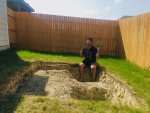- Joined
- Sep 11, 2020
- Messages
- 9
- Reaction score
- 10
- Country

I've documented my experience digging an in-ground garden bed into the dense clay that my home was built on in the north east Austin, TX area.
Most contractors in the Austin Texas area use dense clay to stabilize new home foundations, especially for homes built after 2015. My backyard had a ton of this clay, and building an in-ground bed was a major pain.
I highly recommend buying the following tools to get the job done correctly:
A sturdy flat head pickaxe.
A quality 48 inch round tip shovel, if you don't want the shovel to break, try paying more than 15 dollars.
A quality wheelbarrow with two wheels, this will be so much more helpful than a wheelbarrow with one wheel, the two wheels provide necessary balance when moving heavy clay.
I've started a Youtube channel called "Austin Texas Gardening" for more detail, see the video below -
Most contractors in the Austin Texas area use dense clay to stabilize new home foundations, especially for homes built after 2015. My backyard had a ton of this clay, and building an in-ground bed was a major pain.
I highly recommend buying the following tools to get the job done correctly:
A sturdy flat head pickaxe.
A quality 48 inch round tip shovel, if you don't want the shovel to break, try paying more than 15 dollars.
A quality wheelbarrow with two wheels, this will be so much more helpful than a wheelbarrow with one wheel, the two wheels provide necessary balance when moving heavy clay.
I've started a Youtube channel called "Austin Texas Gardening" for more detail, see the video below -


